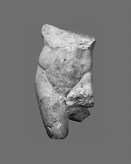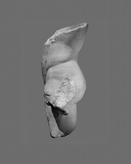- FundeFigs. IV. 14-17
Figs. IV. 14-17
Jerash, Archaeological Museum, formerly Department of Antiquities, garden of the site headquarters (Ottoman castle), without inv.-no.
From Gerasa / Jerash, found in the northern hall of the eastern baths (1984), north of column M (Friedland 2003a, 422 fig.2). The corresponding inscriptional base mentioning the dedication of a statue of Dionysos by the city (base no. 13, Agusta Bularot 2009) has been found in situ in front of the pillar west of the exedra.
Coarse-grained, white marble, according to the isotopic analysis probably from Thasos, Cape Vathy (Friedland 2001).
The upper part of the body is broken from the costal arch the break runs obliquely from the right to the left upward, consequently both arms, shoulders and head are lost. The left leg from the thigh and the right leg from the knee downward are missing with the lower part of the statue including its plinth. The genitalia are battered and the separately worked and inserted penis is lost. The surface is bruised “on either side of navel, lower abdomen, area below pelvic girdle on right, and inner right thigh. Surface broken away on front and sides of both thighs and on back of the right thigh above break. Light reddish-brown incrustations cover upper back and bottom of buttocks.” (Friedland 2003a, 438).
H 92 cm; W 44 cm; D 36 cm.
The torso represents a part of a naked man, upright frontally standing in a relaxed pose with the weight of the body resting on the right leg, the left thigh advancing forward. The pelvis is on all sides delicately modelled with arched groins, separating the abdominal zone from the upper legs. The movement of the legs causes a level shift of the buttocks and a swelling of the buff loins bordering in Polycleitic manner the swallow abdominal plate with the navel. The transitions between these anatomical parts are plastically treated with considerable sculptural skill. The rear side is remarkably well modelled and abraded which may indicate that the statue had been visible also from the rear side.
Later 2nd century AD
Bibl.: Friedland 2001, 466–468 no. 2; figs. 6–8; Friedland 2003a, 437–439 no. 2; 429 fig. 2; Gadara I, 488 no. C 7 pl. 127d–f; Friedland 2007, 342 fig. 1; Kristensen 2013, 226–227 fig. 3.15.





